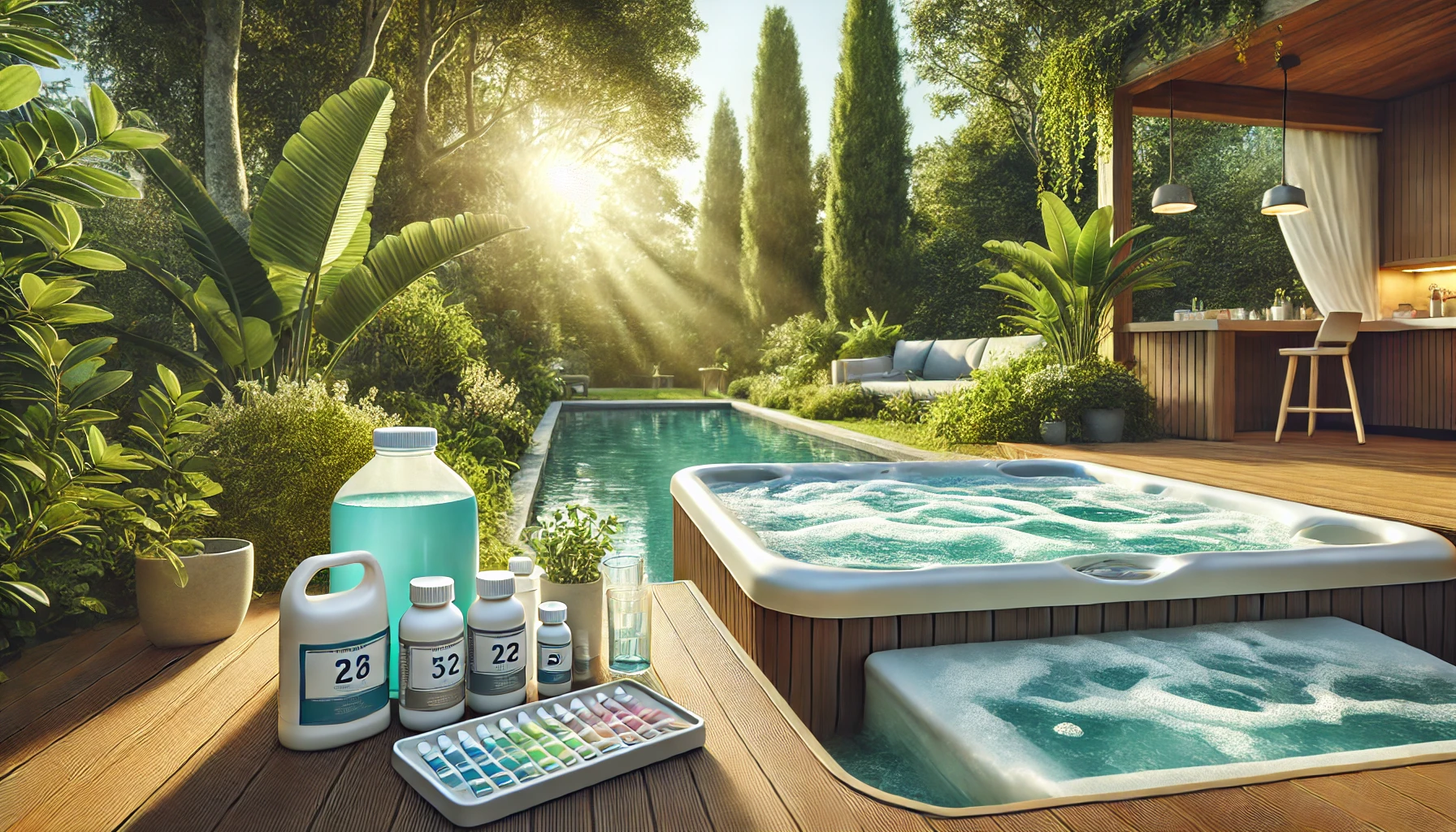Ah, the blissful feeling of sinking into a warm, bubbly hot tub after a long day! But let me tell you, maintaining that crystal-clear water isn’t as effortless as it looks.
Trust me, I’ve learned the hard way that proper hot tub chemical management is crucial for a safe and enjoyable soak. In this article, we’ll dive deep into the world of hot tub chemicals, exploring what you need, how to add them correctly, and some pro tips I’ve picked up along the way.
So grab your test strips, and let’s get started on this bubbly adventure!
Hot Tub Chemicals: What You Need and How To Add Them
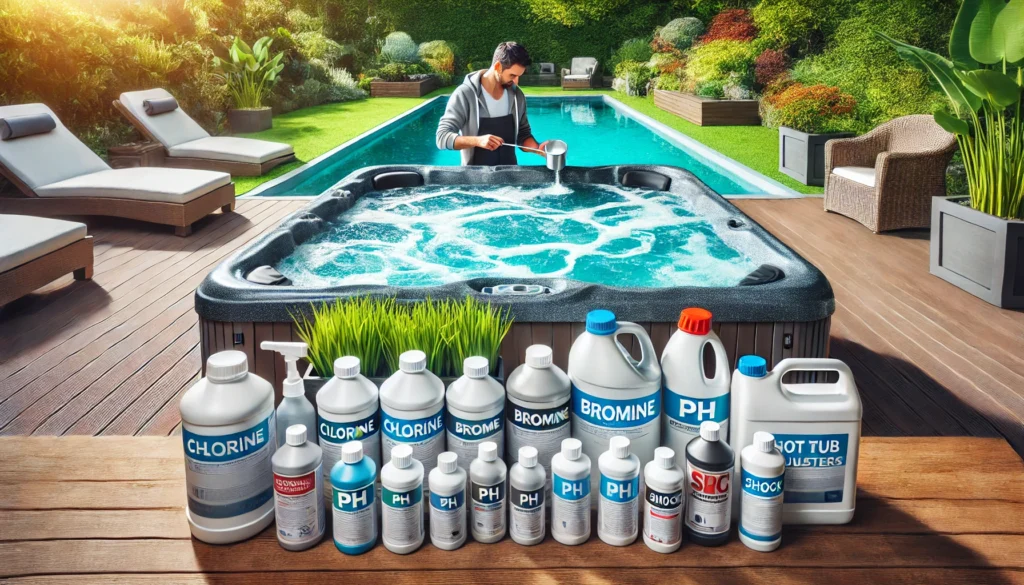
Hot tub chemicals are essential for maintaining clean, safe, and balanced water in your spa. You’ll need sanitizers like chlorine or bromine, pH adjusters, alkalinity increasers, and shock treatments.
To add them, first test your water, then carefully measure and add the required chemicals according to the manufacturer’s instructions. Always add chemicals to the water, not water to chemicals, and run the jets to distribute them evenly.
We’ll explore the topic more deeply below, covering each chemical type and proper application methods to ensure your hot tub stays in tip-top shape all year round.
Essential Hot Tub Chemicals
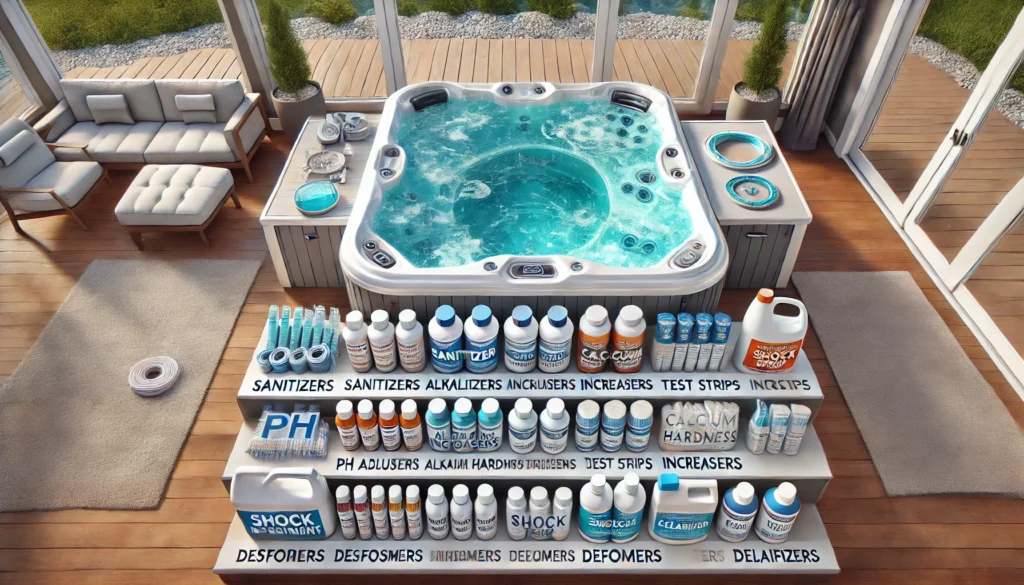
Let’s face it, the world of hot tub chemicals can be overwhelming at first. I remember staring at the shelves of my local pool supply store, feeling completely lost.
But don’t worry, I’ve got your back! Here’s a detailed breakdown of the must-have chemicals for your hot tub arsenal:
- Sanitizers (Chlorine or Bromine)
- These bad boys are your first line of defense against bacteria and other nasties
- Choose between chlorine (faster-acting) or bromine (gentler on skin and eyes)
- I personally prefer bromine, but it’s a matter of personal preference
- Chlorine pros: Cheaper, works faster, easier to find
- Chlorine cons: Stronger odor, can be harsher on skin and eyes
- Bromine pros: Lasts longer, works better in hot water, gentler on skin
- Bromine cons: More expensive, can be harder to find
- pH Adjusters
- pH Up and pH Down to keep your water in the sweet spot (7.2-7.8)
- Trust me, you don’t want to ignore pH levels – I once did, and my skin was not happy!
- High pH can lead to scaling and cloudy water
- Low pH can cause corrosion of your hot tub components and skin irritation
- Tip: Add pH adjusters in small increments to avoid overshooting
- Alkalinity Increaser
- Helps stabilize pH levels and prevent rapid fluctuations
- Think of it as the unsung hero of water balance
- Ideal range is typically between 80-120 ppm (parts per million)
- Low alkalinity can cause pH to bounce around like crazy
- High alkalinity can make it difficult to adjust pH
- Calcium Hardness Increaser
- Prevents water from becoming too “soft” and damaging your tub
- Especially important if you’re using softened water (learned that one the hard way)
- Aim for a range of 150-250 ppm for most hot tubs
- Low calcium hardness can lead to etching and corrosion
- High levels can cause scaling and cloudy water
- Shock Treatment
- Used to oxidize contaminants and refresh your water
- Available in chlorine and non-chlorine versions
- I like to use non-chlorine shock weekly for maintenance
- Use chlorine shock for more heavy-duty cleaning or after heavy use
- Tip: Always shock your tub at night and leave the cover off for a few hours
- Test Strips or Test Kit
- Your trusty sidekick in the battle for balanced water
- I recommend getting a digital tester for more accurate readings
- Test for pH, alkalinity, sanitizer levels, and calcium hardness
- Don’t forget to check your test strips’ expiration date!
- Defoamer
- A handy product to have when your water gets a bit too bubbly
- Helps eliminate excess foam caused by body oils, lotions, or detergents
- Use sparingly – prevention is better than cure!
- Clarifier
- Helps clump together tiny particles so your filter can catch them more easily
- Great for improving water clarity without having to drain and refill
Now that we’ve got our chemical lineup sorted, let’s talk about how to use these bad boys effectively!
How to Add Hot Tub Chemicals

Alright, folks, gather ’round! It’s time for the main event – adding those chemicals to your hot tub.
Now, I know it might seem intimidating at first, but trust me, you’ll be a pro in no time. Here’s my step-by-step guide to getting it right:
- Test Your Water
- Always, always, ALWAYS start by testing your water
- Use those test strips or your fancy digital tester to check pH, alkalinity, and sanitizer levels
- Pro tip: Test at least twice a week, or more if you’re using the tub frequently
- Record your results in a log – trust me, it helps to track trends over time
- Balance pH and Alkalinity First
- These are the foundation of good water chemistry
- Add pH Up or pH Down as needed, following the instructions on the bottle
- Adjust alkalinity with an alkalinity increaser if necessary
- Wait about an hour, then retest and adjust again if needed
- Remember, small adjustments are better than big ones!
- Add Sanitizer
- Whether you’re Team Chlorine or Team Bromine, now’s the time to add it
- Follow the manufacturer’s instructions for the correct amount
- Remember, more is not always better – overdoing it can irritate your skin and eyes
- For chlorine, aim for 3-5 ppm; for bromine, 3-6 ppm
- If using bromine, don’t forget to add sodium bromide when you first fill your tub
- Shock the Water
- I like to shock my tub once a week, or after heavy use
- Use either chlorine or non-chlorine shock, depending on your preference
- Add the shock while the jets are running to distribute it evenly
- If using chlorine shock, wait until levels drop to 5 ppm before using the tub
- For non-chlorine shock, you can usually use the tub after 20-30 minutes
- Wait and Circulate
- After adding chemicals, run the jets for at least 15-30 minutes
- This helps distribute everything evenly and allows the chemicals to do their thing
- I like to use this time to clean the waterline and wipe down the cover
- Retest and Adjust
- Give it a few hours, then test your water again
- Make any final adjustments as needed
- Don’t be discouraged if it takes a few tries to get everything balanced
Remember, patience is key when it comes to hot tub chemistry. I once got impatient and kept adding chemicals without waiting – let’s just say my water ended up looking like a science experiment gone wrong!
Tips for Safe Chemical Handling
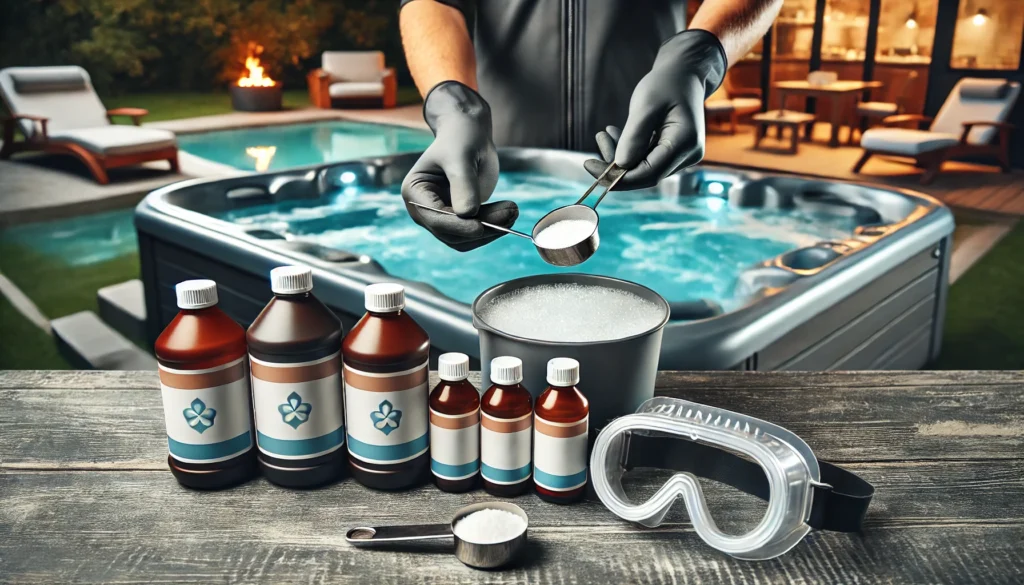
Listen up, because this part is important! Hot tub chemicals can be dangerous if not handled properly.
Here are some tips to keep you safe:
- Always read the labels and follow instructions carefully
- Wear gloves and eye protection when handling chemicals
- Never mix different chemicals together – seriously, don’t do it!
- Store chemicals in a cool, dry place away from direct sunlight
- Keep chemicals out of reach of children and pets
- Add chemicals to water, not water to chemicals (trust me on this one)
- Never use pool chemicals in your hot tub – they’re not the same!
- Wash your hands thoroughly after handling chemicals
- Use a dedicated measuring cup for each type of chemical to avoid contamination
- If you spill chemicals, clean them up immediately and dispose of them properly
I learned some of these lessons the hard way, so learn from my mistakes and stay safe out there!
Troubleshooting Common Water Issues
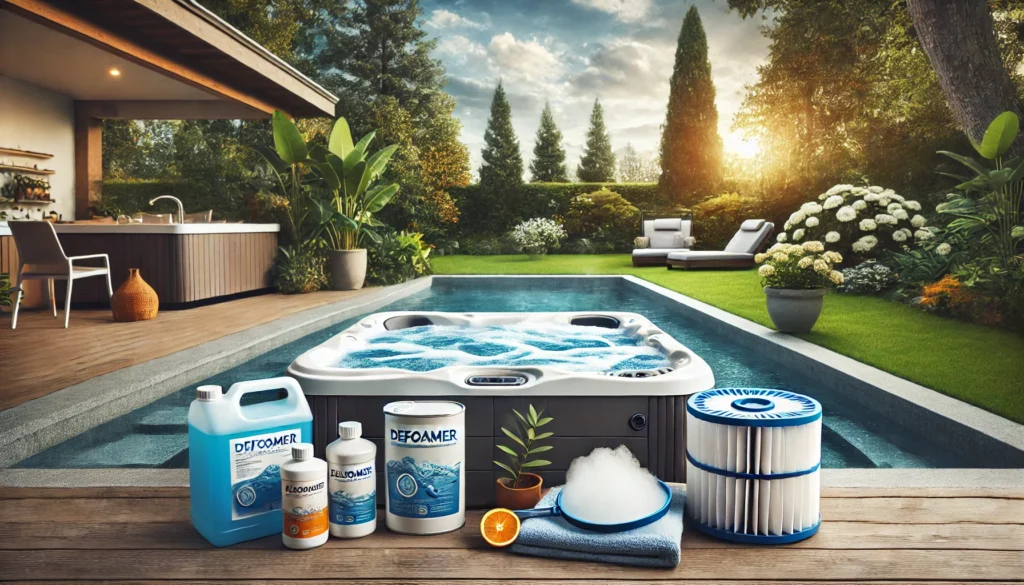
Even with the best intentions, sometimes things can go awry. Here are some common issues and how to fix them:
- Cloudy Water
- Usually caused by poor filtration or chemical imbalance
- Shock the water and clean or replace your filter
- Check pH and alkalinity levels and adjust if necessary
- Consider using a water clarifier to help clump particles together
- Foamy Water
- Often due to soap residue or high calcium hardness
- Use a defoamer and remind your guests to shower before using the tub
- Check for low calcium hardness and adjust if needed
- Run your jets and skim off any foam that forms
- Strong Chemical Smell
- Contrary to popular belief, this often means you need MORE chlorine, not less
- Shock the water and adjust your sanitizer levels
- Make sure your pH is in the correct range
- Consider switching to bromine if the smell persistently bothers you
- Green Water
- Algae alert! Shock the water and clean your filter
- You might need to drain and refill if it’s really bad
- Check your sanitizer levels and make sure they’re high enough
- Clean all your hot tub surfaces with a diluted bleach solution
- Scaling or Calcium Buildup
- Usually caused by high pH or high calcium hardness
- Lower your pH and calcium hardness levels
- Use a scale remover product to dissolve existing buildup
- Consider using a sequestering agent to prevent future scaling
Remember, prevention is better than cure. Regular testing and maintenance will help you avoid most of these issues.
Creating a Hot Tub Maintenance Schedule
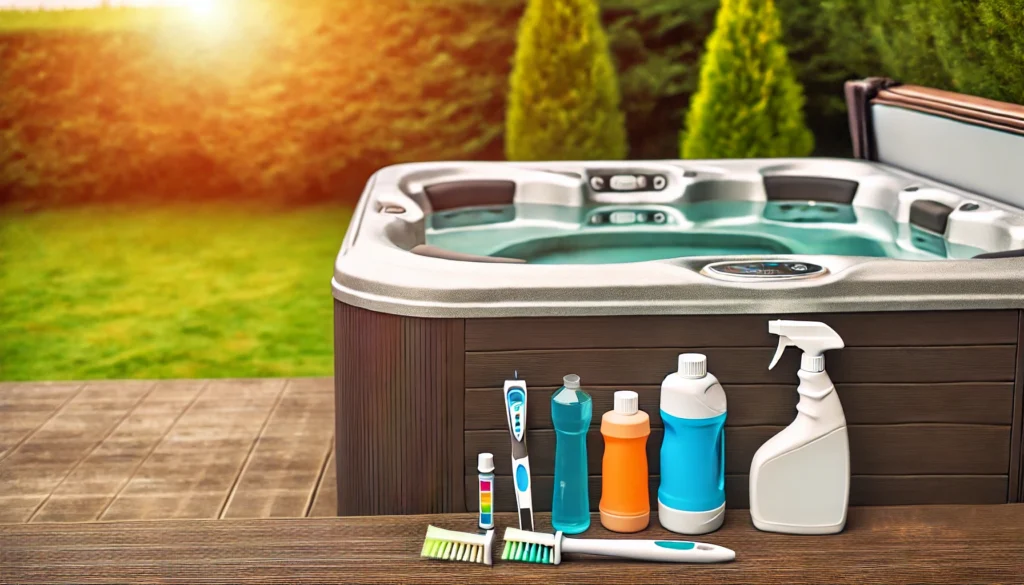
One of the best ways to keep your hot tub in top shape is to create a regular maintenance schedule. Here’s a sample schedule that has worked well for me:
Daily:
- Check water temperature and adjust if needed
- Quickly test sanitizer levels and add more if necessary
Weekly:
- Test all water parameters (pH, alkalinity, sanitizer, calcium hardness)
- Add chemicals as needed to balance water
- Shock the water
- Clean the waterline
- Rinse or clean the filter
Monthly:
- Deep clean the filter (or rotate to a clean one if you have spares)
- Check and clean the hot tub cover
- Flush the jets with a line flush product
Quarterly:
- Drain and refill the hot tub
- Clean the entire shell while it’s empty
- Replace the filter if needed
Remember, this is just a guideline. You might need to adjust based on how often you use your tub and local conditions.
The key is to be consistent!
Conclusion
Whew! We’ve covered a lot of ground, haven’t we? From essential chemicals to proper application methods and troubleshooting tips, you’re now armed with the knowledge to keep your hot tub water sparkling clean and safe.
Remember, maintaining your hot tub might seem like a chore at first, but trust me, it’s worth it when you’re relaxing in that perfectly balanced water.
Don’t be afraid to experiment a bit to find what works best for your tub and your lifestyle. Every hot tub is unique, and what works for me might not be perfect for you.
Keep a log of what you do and how your water responds – it’ll help you fine-tune your maintenance routine over time.
And hey, if you’ve got any hot tub maintenance tips or funny stories of your own, I’d love to hear them! Drop a comment below and share your experiences with the community.
We’re all in this bubbly boat together, after all.
Now, go forth and conquer those hot tub chemicals – your perfect, relaxing soak awaits! Just remember, a well-maintained hot tub is a happy hot tub, and a happy hot tub means happy hot tubbers.
Here’s to many hours of blissful relaxation in your sparkling clean spa!
